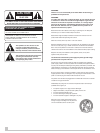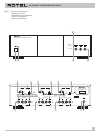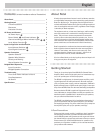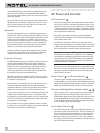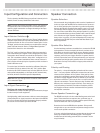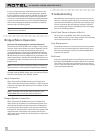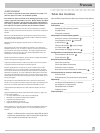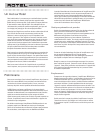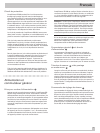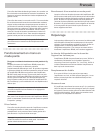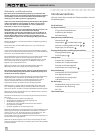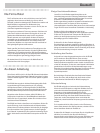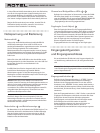
Speaker Connection
Speaker Selection
We recommend using loudspeakers with a nominal impedance of
4 ohms or higher with the RB-976. You should exercise some cau-
tion in driving multiple pairs of speakers in parallel configuration,
because the effective impedance the amplifier sees is cut in half.
For example, when driving two pair of 8 ohm speakers, the ampli-
fier sees a 4 ohm load. When driving multiple speakers in parallel,
it is recommended that you select speakers with a nominal imped-
ance of 8 ohms or higher. Speaker impedance ratings are less
than precise. In practice, very few loudspeakers will present any
problems for the RB-976. See your authorized Rotel dealer if you
have any questions.
Speaker Wire Selection
Use insulated two-conductor stranded wire to connect the RB-976
to the speakers. The size and quality of the wire can have an au-
dible effect on the performance of the system. Standard speaker
wire will work, but can result in lower output or diminished bass
response, particularly over longer distances. In general, heavier
wire will improve the sound. For best performance, you may want
to consider special high-quality speaker cables. Your authorized
Rotel dealer can help in the selection of appropriate cables for
your system.
Polarity and Phasing
The polarity — the positive/negative orientation of the connec-
tions — for every speaker and amplifier connection must be con-
sistent so all the speakers will be in phase. If the polarity of one
connection is mistakenly reversed, bass output will be very weak
and stereo imaging degraded. All wire is marked so you can iden-
tify the two conductors. There may be ribs or a stripe on the insu-
lation of one conductor. The wire may have clear insulation with
different color conductors (copper and silver). There may be po-
larity indications printed on the insulation. Identify the positive
and negative conductors and be consistent with every speaker
and amplifier connection.
Stereo Speaker Connection
8
The RB-976 has six pairs of color coded binding posts on the back
panel. These connectors accept bare wire, connector lugs, or
dual banana type connectors (except in the European Community
countries where their use is not permitted).
Route the wire from the RB-976 to the speakers. Give yourself
enough slack so you can move the components enough to allow
access to the speaker connectors.
If you are using dual banana plugs, connect them to the wires and
then plug into the backs of the binding posts. The hexagonal
thumbscrews of the binding posts should be screwed in all the
way (clockwise).
Input Configuration and Connection
The six chanels of the RB-976 are grouped into 3 channel pairs la-
beled A, B and C for easy identification and control.
Note: To prevent loud noises that neither you nor your speakers
will appreciate, make sure the amplifier is turned off when you
make any signal connections or change the setting of the Input
Selector Switches.
Input Selector Switches
7
When an Input Selector Switch is in the “Stereo”position the two
channels of the channel pair operate independently. When the In-
put Selector Switch for one or more of the channel pairs is in the
“Bridged” position the two channels are combined into one high
power (150 watt) channel. See the “Bridged Mono Operation”
section of this manual for more information.
The “Link” position of the Input Selector Switch connects the in-
puts of the channel pairs togther. In this configuration the inputs
connected to the A channels can also drive the B and/or C chan-
nels. This is sometimes called a “daisy chain” configuration. It is
typically used in custom installations where one set of stereo in-
puts is used to drive mutiple pairs of speakers, which are often lo-
cated in different rooms.
To use the input link function move the Input Selector Switch for
the channel pair(s) you want to link to the “Link” position. Note
that the inputs of the B channels may be linked, while the C chan-
nels operate independently, or the inputs of the C channels may
be linked, while the B channels operate independently.
Note: When the input linking function is used the linked channel
pairs cannot be bridged.
Input Signal Connection
6
[See Figure 2 for normal wiring illustration.]
The RB-976 has conventional RCA type input connectors, the type
found on nearly all audio equipment.
Use high quality audio interconnect cables to connect the outputs
of the preamplifier or signal processor to the inputs of the RB-976.
Be sure to connect the left and right channels properly and that
you use the correct channel pair of the RB-976.
3
English




